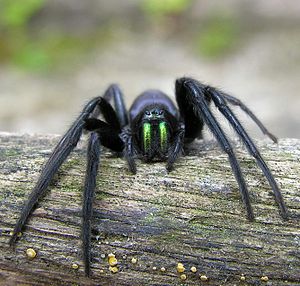Mighty fishing web spider
| Mighty fishing web spider | ||||||||||||
|---|---|---|---|---|---|---|---|---|---|---|---|---|

Mighty fishing web spider ( Segestria florentina ), female |
||||||||||||
| Systematics | ||||||||||||
|
||||||||||||
| Scientific name | ||||||||||||
| Segestria florentina | ||||||||||||
| ( Rossi , 1790) |
The mighty fishing web spider ( Segestria florentina ) is a web spider from the family of fishing web spiders (Segestriidae). In Europe it is the largest type of family. As with all fishing web spiders, the six eyes of the mighty fishing web spider are arranged in two pointed triangles facing each other on the forehead.
description
The females reach a body length of up to 22 mm, the males up to 15 mm. This species is the darkest species in this family. While young animals have a grayish abdomen (Opisthosoma), which has a similar pattern to the closely related common fishing web spider ( Segestria senoculata ), adult animals are almost uniformly black. A striking and typical feature of the mighty fishing web spider is the metallic green shimmer of the large chelicerae. This color is a structural color that is created by a grid of chitin lamellas.
distribution and habitat
The original home of the mighty fishing web spider is the Mediterranean area , it occurs eastwards through Turkey to the Crimea and the Caucasus . In its area of origin it populates crevices and tree trunks, e.g. B. plane trees , where they live under loose tree bark, but particularly often coarse-jointed masonry of buildings. Further north it lives exclusively synanthropically on walls and structures. Because of its size, it needs large and deep crevices in the wall, such as those found above all in castles, churches and broken stone walls. The species is tied to the maritime climate , especially in the north of its range . It populates the Iberian Peninsula and western France from Normandy to the south. Towards the east it is increasingly tied to areas close to the sea. The eastern border of the distribution runs through the province of Zeeland in the Netherlands. This limit seems to be mainly due to the low winter temperatures away from the Gulf Stream. In England it was tied to a few port cities on the south coast until the 1980s, but has shown a clear trend towards the north for some years. Finds are now available north to Gloucestershire and Essex . The spider has only been reported three times from Germany. The species reaches Switzerland in the south (Ticino) and is absent in Austria.
Way of life
The mighty fishing net spider builds a typical family tubular web in the crevices and cracks that opens outwards like a funnel. Long signal threads go out from this funnel opening. At night the spiders wait near the opening of the funnel. If a prey touches the signal threads, it can be quickly located and bitten by the spider. The prey is then pulled into the pipe network.
Bites
Mighty fishing web spider bites are painful. One case is reported in which, in addition to severe pain and swelling of the bite site, fever, dizziness and headache were the result. The pain often subsides after a few hours. The poison contains a neurotoxin that specifically inhibits a type of calcium channel (type N, which is mainly found in neurons) in the cell membrane.
Individual evidence
- ↑ a b c Heiko Bellmann: Der Kosmos Spinnenführer: Over 400 Species of Europe , 1st edition. Edition, Kosmos (Franckh-Kosmos), 2010, ISBN 3440101142 .
- ↑ a b Nentwig W., T. Blick, D. Gloor, A. Hänggi & C. Kropf (2010): Araneae, Spinnen Europa (identification key). University of Bern.
- ↑ AL Ingram, AD Ball, AR Parker, O. Deparis, J. Boulenguez, S. Berthier: Characterization of the green iridescence on the chelicerae of the tube web spider, Segestria florentina (Rossi 1790) (Araneae, Segestriidae) . Journal of Arachnology 37, 1, 2009, pp. 68 - 71. doi : 10.1636 / SH07-87.1
- ↑ Csaba Horváth Roland Szinetár & A review of spiders on tree trunks in Europe (Araneae). Acta zoologica bulgarica, Suppl. 1: 221-257.
- ↑ PJ van Helsdingen: The presence of Segestria florentina (Rossi) in The Netherlands. Bulletin de la Société européenne d'Arachnologie No. hors serie 1, Paris 1990, pp. 353-357. download ( Memento of the original from October 11, 2008 in the Internet Archive ) Info: The archive link was inserted automatically and has not yet been checked. Please check the original and archive link according to the instructions and then remove this notice.
- ↑ Michael J. Roberts: The spiders of Great Britain and Ireland. Volume 1, Atypidae to Theridiosomatidae. Harley Books, Colchester 1985, p. 62.
- ^ David Haigh: Segestria florentina (Rossi, 1790) - A spider new to North Gloucestershire. Newsletter of the British Arachnological Society 114, 2009, p. 15.
- ^ Peter Harvey: An Essex Population of Segestria florentina (Rossi, 1790). Newsletter of the British Arachnological Society 99, 2004, pp. 11-12.
- ↑ Evidence map of Segestria florentina in Germany
- ↑ Konrad Thaler, Barbara Knoflach: On the faunistics of the spiders (Araneae) of Austria: Atypidae, Haplogynae, Eresidae, Zodariidae, Mimetidae. In: Linz Biological Contributions. Volume 34, Issue 1, Linz 2008, pp. 413–444 ( PDF on ZOBODAT ).
- ↑ Science & Nature - Wild Facts - Tube web spider . BBC. Archived from the original on June 8, 2009. Info: The archive link was automatically inserted and not yet checked. Please check the original and archive link according to the instructions and then remove this notice. Retrieved September 26, 2009.
- ↑ A case of arachnidism by Segestria florentina (Rossi, 1790) (Araneae, Segestriidae) in Salento.
- ↑ Tube web spider, Segestria florentina | Natural History Museum . Nhm.ac.uk. Retrieved September 26, 2009.
- ↑ Lachlan D. Rash, Wayne C. Hodgson: Pharmacology and biochemistry of spider venoms. Toxicon Volume 40, Issue 3, 2002, pp. 225-254. doi : 10.1016 / S0041-0101 (01) 00199-4